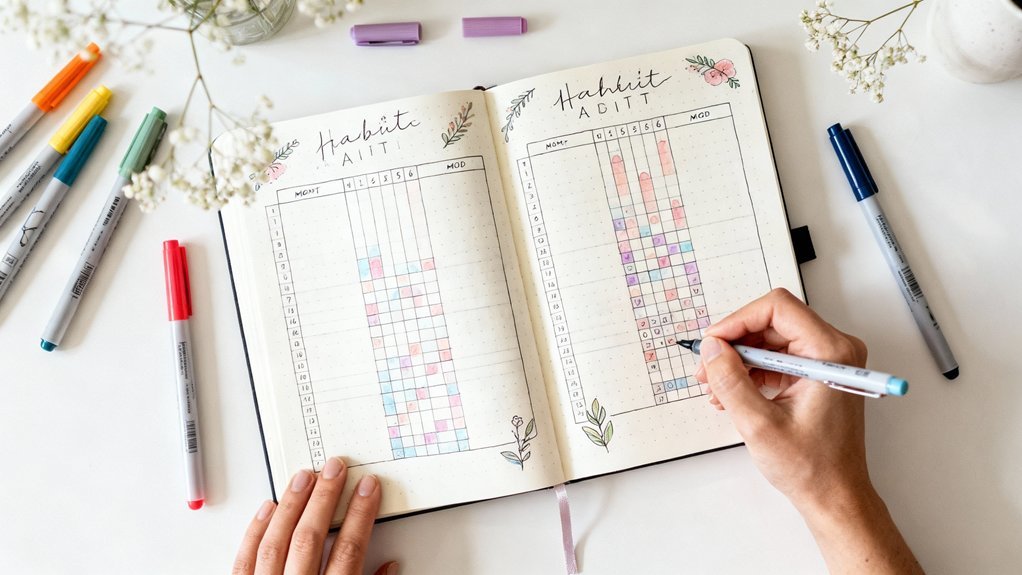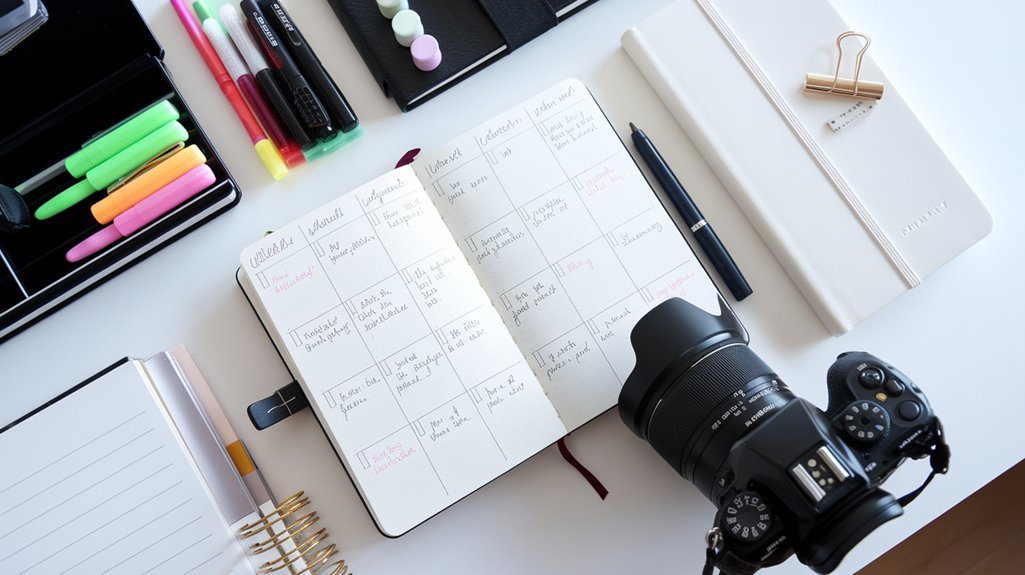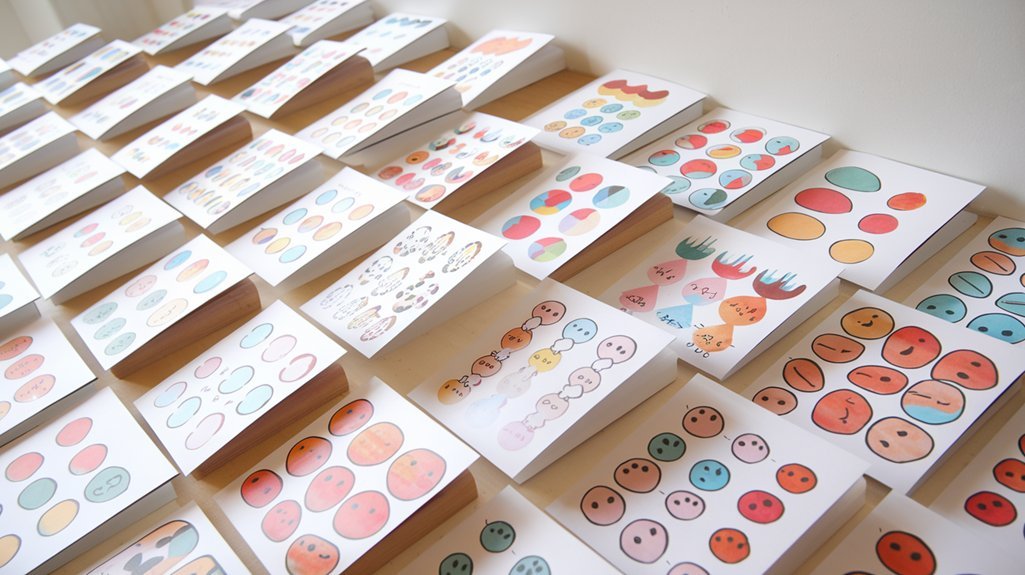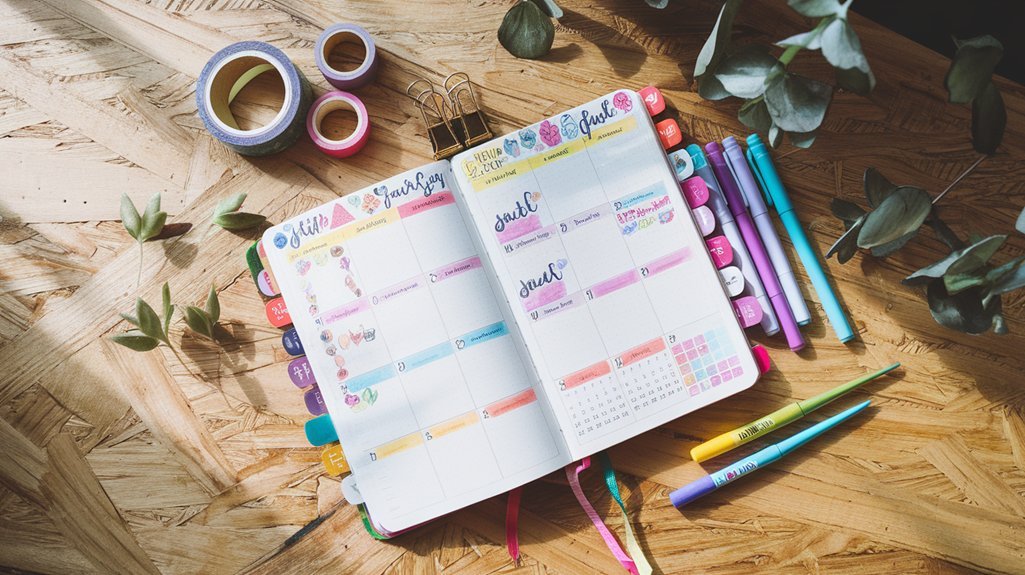You'll want a book tracker that balances simplicity with meaningful data capture. Start with minimalist layouts featuring title, author, dates, and completion status—whether in bullet journals or digital apps like Notion. Add visual elements like progress bars, color-coded genres, and reading statistics to convert raw numbers into motivational insights. Include structured review sections with rating systems and quote archives to preserve your literary journey. Choose templates that match your consistency level, from daily logs to monthly challenges. The following sections break down each tracking method's specific implementation strategies.
Key Takeaways
- Minimalist layouts focus on essential data—title, author, dates, and completion status—eliminating clutter while maintaining functionality across digital and analog formats.
- Visual progress trackers like bookshelf illustrations, thermometer charts, and color-coded systems transform reading goals into tangible, motivating displays.
- Digital solutions such as Notion, Airtable, and specialized apps offer customizable templates with sortable fields, cloud sync, and ISBN scanning capabilities.
- Analytics dashboards visualize reading statistics through charts and graphs, tracking pages per day, completion rates, genre distribution, and seasonal patterns.
- Challenge trackers set measurable goals with progress bars and tiered levels, while detailed review layouts use structured prompts and rating systems.
Minimalist Book List Layouts for Simple Tracking
A minimalist book list layout strips away decorative elements to focus on essential information: title, author, and completion status.
You'll find that simple layouts enhance efficiency by eliminating visual clutter that distracts from your reading goals.
Your minimalist design should prioritize functionality through clean lines and strategic white space.
Create columns for core data points: book title, author name, start date, finish date, and a checkbox or symbol indicating completion. You can add a rating system using numbers or symbols if desired.
This approach lets you scan your reading history quickly and identify patterns in your consumption habits.
You'll spend less time maintaining elaborate spreads and more time reading actual books.
Simple layouts also adapt effortlessly across different mediums—whether you're using a bullet journal, digital spreadsheet, or note-taking app.
The optimized format guarantees your tracking system remains sustainable long-term, supporting your commitment to consistent reading without overwhelming administrative overhead.
Bullet Journal Book Tracker Spreads and Design Ideas
Bullet journal book trackers change your reading habits into organized visual systems that combine functionality with creative expression.
You'll benefit from monthly reading log layouts that chronologically document your progress, visual tracking methods that display completion status at a glance, and genre-mood spreads that categorize books by type and emotional tone.
These three design approaches work together to create a thorough tracking system tailored to your specific reading patterns and goals.
Whether you're new to journaling or looking to enhance your existing system, time management techniques can help you consistently maintain your reading tracker while building a more purposeful relationship with your books.
Monthly Reading Log Layouts
When you're managing your reading life month by month, a dedicated monthly reading log provides the perfect middle ground between daily tracking and annual overviews.
Structure your layout with columns for title, author, start date, completion date, and rating. Add visual elements like color-coded bars representing your favorite genres to identify reading patterns instantly.
Include metrics that reveal your reading habits: pages read, genre distribution, and time invested per book. Design a mini calendar highlighting reading days to spot consistency gaps.
Integrate a notes section for capturing immediate reactions and main insights. Create a monthly statistics box displaying total books completed, average rating, and fastest read.
This systematic approach converts scattered reading data into practical insights, enabling you to refine your literary journey continuously.
Visual Progress Tracking Methods
Convert your reading goals into engaging visual experiences through strategic bullet journal spreads that merge functionality with creativity.
You'll alter abstract targets into tangible achievements using graphical representations that adapt to your reading style.
Design thermometer-style trackers where colored segments rise as you complete books, or create bookshelf illustrations where each spine represents a finished title.
Implement circular progress wheels divided into segments marking progress milestones, allowing quick visual assessment of your advancement.
Utilize color-coding systems that distinguish genres, difficulty levels, or reading speeds.
Map reading streaks through chain-link patterns or calendar grids with meaningful symbols.
Deploy bar graphs comparing monthly totals, revealing patterns in your reading habits.
These methodical approaches maintain momentum while providing immediate feedback on your literary journey's trajectory.
The Bullet Journal Method's writing and reflection practices transform these visual trackers into tools that help you reconnect with what truly matters in your reading life.
Genre and Mood Spreads
Beyond tracking completion rates, organizing your reading log by genre and emotional tone reveals patterns that shape your literary preferences and helps curate future selections strategically.
Design spreads with dedicated sections for fiction, non-fiction, mystery, or romance—whatever categories align with your collection. Color-code entries or use distinct symbols to facilitate quick visual scanning.
For mood categorization, create emotional mapping systems that tag books as uplifting, contemplative, dark, or humorous. This framework proves invaluable when you're seeking specific reading experiences.
Implement dual-axis charts plotting genre exploration against mood ratings, revealing which combinations resonate most. Track seasonal reading patterns to identify when certain genres appeal strongest.
These analytical spreads convert casual reading habits into data-driven discovery, enabling smarter book selections that consistently satisfy your evolving tastes.
Digital Book Tracking Templates and Apps
As readers increasingly manage their lives through smartphones and tablets, digital book tracking solutions offer sophisticated alternatives to paper-based systems. Digital templates in apps like Notion, Airtable, and Google Sheets provide customizable frameworks you can adapt to your reading preferences. You'll find pre-built databases with sortable fields for titles, authors, ratings, and completion dates.
Tracking apps deliver specialized functionality beyond basic spreadsheets. Goodreads and StoryGraph offer social features, personalized recommendations, and reading statistics. For focused tracking, consider these options:
| Feature | Best For |
|---|---|
| Automated statistics | StoryGraph, Basmo |
| Social integration | Goodreads, LibraryThing |
| Customization | Notion templates, Airtable |
You'll benefit from cloud synchronization across devices, automated data backup, and visual analytics displaying your reading patterns. Many apps incorporate ISBN scanning, eliminating manual data entry. Choose platforms offering export capabilities to maintain ownership of your reading data.
Reading Statistics and Data Visualization Layouts

When you convert raw reading data into visual formats, patterns emerge that simple lists can't reveal. Strategic visualization techniques elevate your reading habits into actionable statistical insights through charts, graphs, and heat maps that highlight consumption patterns across genres, authors, and time periods.
Effective data analysis requires tracking performance metrics like pages per day, completion rates, and reading speed averages. You'll discover trend tracking becomes intuitive when dashboards display monthly comparisons, yearly progressions, and genre distributions through pie charts or bar graphs. These layouts enrich user engagement by making abstract numbers tangible and compelling.
Dashboards transform reading metrics into intuitive visual trends, making monthly comparisons and genre patterns immediately accessible and actionable.
Advanced trackers incorporate reader demographics analysis, revealing correlations between mood ratings and book selections or identifying peak reading times. Heat map calendars visualize consistency, while line graphs expose seasonal fluctuations in your literary consumption.
This methodical approach to data visualization equips you to refine reading schedules, diversify selections, and establish evidence-based goals that align with your evolving preferences.
Genre-Based Organization Systems
Organizing your book tracker by genre creates a systematic framework that reflects your reading preferences and helps you maintain balanced literary consumption.
You'll implement this through two primary methods: color-coding, where you assign specific colors to represent different genres throughout your tracker, and dedicated genre sections, where you allocate separate pages or areas for each category.
This approach converts raw reading data into structured information that reveals patterns in your genre choices and identifies gaps you might want to fill.
Color-Coding by Genre
Start by selecting 6-8 core genres that dominate your reading habits.
Assign each a unique color using highlighters, colored pens, or digital tools.
Apply these consistently across title entries, spine decorations, or progress bars.
This systematic approach reveals genre imbalances quickly, prompting you to diversify your selections.
The resulting color patterns convert raw data into practical information about your literary preferences.
Dedicated Genre Sections
For readers managing extensive collections across multiple genres, dedicating separate tracker sections to each category creates a structured organizational framework. You'll establish clear boundaries that reflect your genre preferences while maintaining visual distinction through section aesthetics.
| Genre Section | Tracking Elements | Layout Strategy |
|---|---|---|
| Mystery/Thriller | Clues, twists, suspense rating | Dark borders, puzzle icons |
| Fantasy/Sci-Fi | World-building notes, series order | Ethereal colors, constellation markers |
| Literary Fiction | Theme analysis, character depth | Minimalist design, quote spaces |
Configure each section with genre-specific metrics that capture unique reading elements. Mystery sections might include plot complexity ratings, while romance sections track emotional intensity scores. This segmentation prevents cross-contamination between different reading experiences and enables rapid location of titles within your preferred categories. You'll convert scattered entries into a cohesive, navigable system.
Monthly and Yearly Reading Challenge Trackers
Reading challenges change your book-tracking practice from passive recording into an active pursuit with measurable milestones.
You'll establish clear parameters through goal setting—whether that's 50 books annually or three titles monthly—creating quantifiable targets that drive consistent reading habits.
Your tracker should incorporate progress bars, numerical counters, and percentage calculations that visualize advancement toward completion.
Design separate modules for monthly sprints and yearly marathons, allowing you to toggle between short-term wins and long-range objectives.
Include designated spaces for accountability partners who'll monitor your progress and maintain momentum during slower periods.
Add columns for tracking genres read, page counts, and reading pace metrics to identify patterns in your consumption habits.
Consider implementing tiered challenge levels—bronze, silver, gold—that accommodate fluctuating schedules without abandoning your goals entirely.
Color-coding systems can distinguish between completed, in-progress, and abandoned attempts, providing honest assessment of your reading trajectory throughout the tracking period.
Detailed Review and Rating Layouts
Beyond numerical ratings, thorough review layouts convert superficial impressions into documented literary analysis that deepens your relationship with every book you complete.
Strategic review formats enable systematic reflection that changes casual reading into meaningful engagement. Design layouts that capture multidimensional responses through rating scales addressing plot, character development, prose quality, and emotional impact. These granular assessments reveal patterns in your literary preferences.
Multidimensional rating scales transform reading from passive consumption into systematic literary exploration, revealing hidden patterns in your aesthetic preferences.
Effective review templates incorporate:
- Structured prompts that guide analytical thinking beyond “liked it” or “didn't like it”
- Comparative frameworks connecting themes, writing styles, and narrative techniques across your reading history
- Visual rating systems using stars, color codes, or custom symbols for quick reference
Your review formats should balance spontaneous reactions with deliberate evaluation. Include sections for immediate impressions captured post-reading and space for reflections added weeks later.
This temporal dimension tracks how books resonate over time, distinguishing momentary entertainment from lasting literary significance. Archive favorite quotes alongside contextual notes explaining their impact.
Visual Reading Progress Displays

When you convert abstract reading goals into concrete visual representations, progress becomes tangible and motivation intensifies through immediate feedback loops that numerical lists can't provide.
Interactive visualizations reshape your reading journey into engaging displays. Implement progress bars that fill as you advance through pages, creating immediate satisfaction with each reading session. Design thermometer-style trackers for annual book goals, coloring segments to represent completed titles.
Configure circular charts that display percentages, allowing you to monitor daily or weekly reading streaks. Adopt shelf illustrations where you color book spines upon completion, building a visual library. Establish calendar heat maps that shade days based on reading time invested.
Create mountain-range graphs tracking pages read monthly, revealing patterns in your consumption habits. These visual systems activate reward pathways in your brain, sustaining momentum during challenging reading periods.
They'll help you identify trends, celebrate milestones, and maintain accountability without requiring complex spreadsheet management.
Printable Book Tracker Templates for Physical Planners
Physical planner users gain distinct advantages through dedicated printable templates that bridge digital functionality with tangible interaction.
These templates alter your reading journey into a hands-on experience where creative design meets practical tracking needs.
You'll discover templates enhanced for standard planner sizes—A5, half-letter, and personal formats—ensuring smooth integration with your existing system.
Tracker customization enables you to modify fields, adjust layouts, and incorporate unique elements that reflect your reading preferences.
Consider these template features for maximum functionality:
- Modular layouts that stack vertically or arrange horizontally based on your available planner space
- Hybrid tracking systems combining quantitative metrics (pages read, completion percentages) with qualitative notes (favorite quotes, character observations)
- Color-coding frameworks designating genres, reading priorities, or completion statuses through strategic visual markers
Download templates in PDF format for immediate printing, or choose editable versions that accommodate ongoing tracker customization.
Select cardstock for durability or standard paper for lightweight portability within your planner ecosystem.
Frequently Asked Questions
How Do I Track Books I've Abandoned or Didn't Finish Reading?
Create a dedicated “DNF” (Did Not Finish) section in your tracker where you'll log abandoned titles with specific abandoned book reasons—pacing issues, mismatched expectations, or timing problems.
Include columns for pages completed, abandonment date, and whether you're open to revisiting. This data reveals patterns in your reading preferences and helps refine future selections.
Apply reading motivation tips by reviewing this section periodically; you'll discover what genuinely engages you and make smarter book choices moving forward.
Can I Track Audiobooks and Physical Books in the Same Tracker?
You'll *love* the irony: despite living in a digital age, you can absolutely merge old and new reading formats in one tracker.
Simply add a column designating audiobook formats versus physical book differences. You'll systematically categorize each entry by medium, noting listening time for audio versus page count for print.
This organized approach lets you track completion rates, preferred formats, and reading patterns across both mediums—giving you thorough insights into your evolving literary habits.
What's the Best Way to Remember Where I Heard About Book Recommendations?
Add a dedicated “Source” column to your tracker to capture recommendation sources systematically.
You'll want to log specific tracking methods like “Friend's Name,” “Podcast Episode + Timestamp,” “Bookstagram Handle,” or “Book Club Discussion.”
Consider creating dropdown menus with your most frequent sources for faster data entry.
This organized approach lets you analyze which recommendation sources yield your favorite reads, helping you prioritize where you'll discover books that truly resonate with your preferences.
How Do I Track Books I've Lent to Friends or Borrowed?
Neither a borrower nor a lender be—unless you're tracking it properly.
Create a dedicated lending history section with columns for book title, friend's name, loan date, and expected return date. For borrowed books, maintain a separate borrowing timeline that mirrors this structure, adding the lender's contact information.
You'll want to include status indicators—like “out,” “returned,” or “overdue”—and set calendar reminders. This systematic approach converts chaotic book exchanges into an organized, accountable lending library system.
Should I Track Rereads Separately From First-Time Reads?
You'll enhance reread benefits by creating distinct tracking sections.
Design separate columns or pages that differentiate initial reads from subsequent encounters—this reveals pattern evolution in your interpretation.
Your tracking methods should include date stamps for each reading, notes comparing insights, and rating variations over time.
This systematic approach lets you quantify how your perspective shifts, identify books worth revisiting, and analyze which genres or themes resonate differently as you grow intellectually and emotionally.
Conclusion
You've now assembled your reading toolkit—consider it your literary compass. Whether you're drawn to minimalist lists, vibrant bullet journal spreads, or data-driven statistics, you'll find a tracking method that fits your unique reading style. Start with one layout, test its functionality, and adjust as needed. Remember, you're building a sustainable system that'll grow with your reading journey. Choose your tracker, mark your first book, and watch your personal library flourish.










